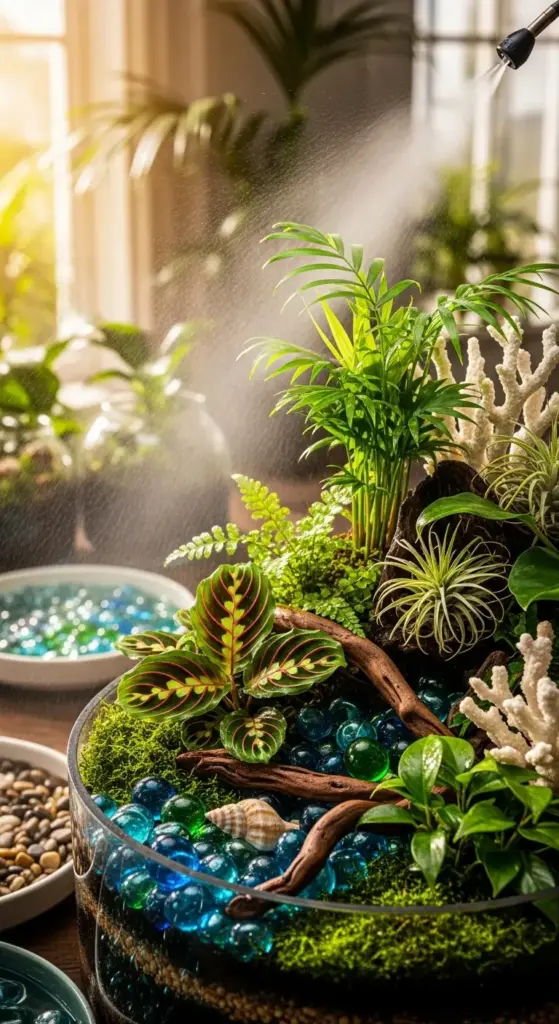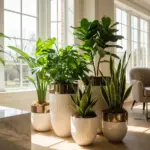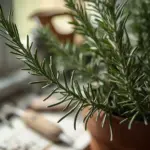5. The Tropical Oasis Creation

I’ll be honest – my first tropical terrarium turned into a moldy mess within three weeks. Apparently, there’s a fine line between “lush tropical paradise” and “science experiment gone wrong.”
But once I figured out the humidity game, these displays became my absolute favorites. There’s something about that jungle vibe that makes even the dreariest winter day feel like vacation.
Humidity-Loving Plants That Actually Stay Small
Small palms are the backbone of any tropical display, but choosing the right variety is crucial. I learned this after my parlor palm outgrew its container in six months.
Neanthe bella palms stay naturally compact and handle lower light better than most. They’re basically the perfect terrarium palm if you can find them.
Prayer plants with their gorgeous patterned leaves add incredible visual interest. The red prayer plant has these stunning burgundy undersides that show when the leaves fold up at night.
Calathea varieties are technically prayer plants too, and they come in amazing patterns. Calathea orbifolia has these huge round leaves with silver stripes that look almost painted.
Tropical ferns bring that authentic rainforest feeling. Button ferns stay small and have this perfect delicate texture that photographs beautifully.
Maidenhair ferns are gorgeous but honestly? They’re drama queens about humidity. I’ve killed more of these than I care to admit before switching to hardier varieties.
Creating Microclimates That Actually Work
This is where the magic happens – creating humidity without turning your display into a swamp.
Pebble trays are your best friend here. I fill shallow dishes with decorative stones and keep them filled with water. As it evaporates, it creates perfect localized humidity.
The key is keeping plant roots above the water line – you want humidity, not soggy soil. I learned this after rotting the roots on a beautiful Boston fern.
Misting techniques took me forever to get right. Too much and you get fungal problems, too little and your plants look sad and crispy.
I mist in the morning so plants have time to dry before evening. Evening misting can lead to bacterial issues that’ll kill your plants faster than you can say “tropical paradise.”
Grouping plants together naturally increases humidity around the entire display. They create their own little ecosystem that’s way more stable than individual containers.
Glass cloches work amazingly for individual plants that need extra humidity. I use vintage ones I found at thrift stores – they look intentional and elegant.
Decorative Elements That Transport You
Driftwood is absolutely essential for that authentic tropical feel. I collect pieces from lake beaches, but craft stores sell gorgeous pieces too.
Soak driftwood for at least 24 hours before using it. I learned this after my water turned brown and stayed that way for weeks. Not cute.
Tropical shells add that perfect beachy element. Cowrie shells and small conch shells work best – avoid anything too large that overwhelms the plants.
Colored stones in blues and greens mimic tropical waters. I use glass gems from the dollar store because they catch light beautifully and don’t break down over time.
Coral pieces (fake ones, obviously) create amazing focal points. The white branching varieties look especially stunning against dark green foliage.
Air plants tucked into driftwood crevices add another layer of tropical authenticity. Spanish moss draped carefully creates that mysterious jungle atmosphere.
Container Selection for Moisture Control
This is where I made my biggest mistakes early on. Tropical plants need consistent moisture but not waterlogged conditions.
Glass containers with wide openings work best because they allow for air circulation while maintaining humidity. Those narrow-necked bottles look cute but create stagnant air.
Drainage is still crucial even for humidity-loving plants. I use the same layering system as my other terrariums – stones, charcoal, then soil.
Glazed ceramic containers retain moisture better than unglazed terra cotta. I found gorgeous turquoise ones that perfectly complement the tropical theme.
Size matters more than you think – containers that are too small dry out too quickly, while oversized ones can stay soggy and develop fungal problems.
Self-watering containers work amazingly well for tropical displays. The consistent moisture level keeps plants happy without the guesswork.
Troubleshooting the Most Common Problems
Brown leaf tips usually mean low humidity, not underwatering. I spent months overwatering plants when all they needed was more moisture in the air.
Yellowing leaves typically indicate overwatering or poor drainage. Check your soil – if it’s soggy, you’ve got drainage issues to fix.
Fungal problems show up as white fuzzy growth on soil or leaves. This usually happens from poor air circulation or evening watering that doesn’t dry properly.
Scale insects love tropical plants and look like tiny brown bumps on stems and leaves. I treat them with rubbing alcohol on a cotton swab – works every time.
Leaf drop can be from temperature shock, overwatering, or sudden changes in humidity. These plants hate dramatic environmental changes.
Crispy, curling leaves scream low humidity. Increase misting frequency and add more pebble trays around your display.
Root rot smells terrible and turns roots black and mushy. If you catch it early, you can sometimes save plants by repotting in fresh, well-draining soil.
Ready to find your inner peace? The next section reveals how to create a zen meditation garden that actually helps calm your mind and reduce stress. I’m talking about the specific plant combinations that promote tranquility and the simple sand patterns that became my daily mindfulness practice. Click “next” to discover the peaceful sanctuary that transformed my chaotic mornings!









GIPHY App Key not set. Please check settings